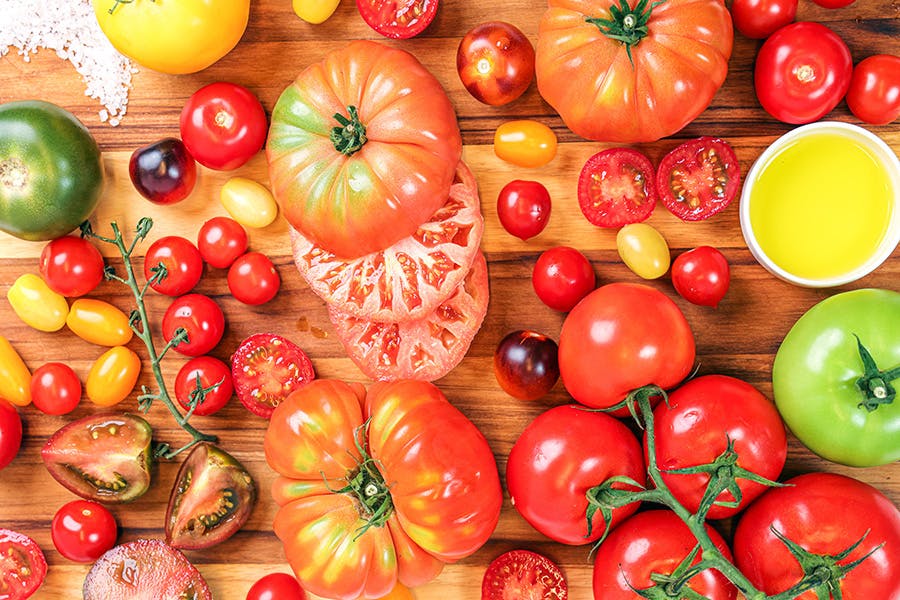You say tomato; we say pomodoro. Let’s call the whole thing off and explore the delicious ways to eat the juicy, sun-ripened fruit!
It’s hard to believe that tomatoes – so closely identified with Italian cuisine – are not native to Europe–but in fact, the almost-magical plant was completely unknown to Italians until the early 16th century. Italians named the round fruit – an especially acidic yellow variety – pomo d’oro, which translates to “golden apple.”
Wary of poisonous produce, northern Italians didn’t fall for the tomato immediately; however, the less affluent southern regions eventually warmed up to the versatile ingredient. The Mediterranean climate offered an ideal growing environment, and farmers began to experiment with more varieties. Today, pomodori are grown across Italy.
From choosing the perfect variety to exploring our favorite recipes, learn all about the Italian way with tomatoes!

1. GET VARIETAL.
Like wine and olive oil, tomato varieties differ across Italy, from north to south. There are hundreds of varieties; here’s a small tasting.
Roma: A plum tomato from – you guessed it – Roma, this variety is recognizable by its elongated pear shape and loved for its sweet flavor. Its slender and firm consistency makes it ideal for canning and tomato paste.
Cuore di Bue: Originally grown in northern Liguria, this beefsteak tomato’s juicy and dense flesh is perfect for sauce, pesto, and even jams. Its name, which means “ox heart,” stems from its large size and distinctive bottom-heavy shape.
Pachino: The Pomodoro di Pachino IGP is grown on the coast of southern Sicilia. Small and round, the tomato is sweet and pairs well with lighter dishes, such as seafood.
Piennolo: Also called “pomodorino vesuviano,” or “little Vesuvian tomato,” this DOP-certified variety is actually grown on the slopes of Mt. Vesuvius. The small, bright-red tomato is traditionally grown in clusters on the vine and can be distinguished by its distinctive teardrop end.
Pisanello: Named for the Renaissance painter, Pisanello tomatoes are grown in Toscana. The short, fat, and ribbed variety nicely balances sweetness and acidity, making it perfect for savory bruschetta.
San Marzano: Perhaps one of the best known varieties, the San Marzano tomato is a DOP-certified plum tomato, thin and pointed, which is grown near Napoli. Its bittersweet taste – making it perfectly suited to a variety of dishes – is beloved across the world.
2. CHOOSE YOUR PRODUCT.
Italians have perfected many ways to preserve pomodori, so you can enjoy the sun-warmed fruit of the Mediterranean even during a Wyoming winter. At Eataly, we cook with the delicious tomato products all year round.
Concentrato di Pomodoro: Tomato paste is a strong concentrate to be used in small amounts. When you ask a chefly person for their “secret ingredient” in a soup, pasta, etc., they often point to this paste, which adds a rich depth of flavor.
Passata di Pomodoro: From sauce to soup — anytime you need a smooth texture, turn to simple, high-quality tomato puree.
Polpa di Pomodoro: Similar to passata, this tomato "pulp" is an unstrained version of tomato puree, with seeds still included and slightly more liquid.
Pomodori Pelati: Whole peeled tomatoes are perfect crushed to make a chunky tomato sauce, add to soups, and beyond.
Pomodori Secchi: Savory and delicious, sun-dried and semi-dried tomatoes are stored in olive oil. After draining them, we love to serve them minced in salads, soups, and pasta – or added to pesto for extra depth of flavor.
3. START COOKING!
Now that you're an expert, you are ready to incorporate the delicious fruit into your daily cuisine. From complicated recipes to simple snacks, there are hundreds of ways to enjoy tomatoes. Here are a few of our favorites!
Basic tomato sauce: From spaghetti to pizza, many beloved Italian dishes call for a basic tomato sauce.
Pizza Margherita: Paying homage to the Italian flag, tomatoes are front and central in this iconic pizza.
Caprese: This traditional salad is a delicious and easy ode to the tomato. Simply combine freshly-made mozzarella, your choice of pomodoro, and basil. Finish with a drizzle of olive oil, and enjoy.